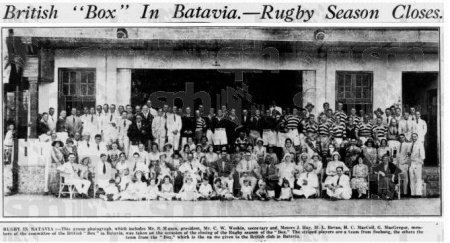In the early 1900’s the British colony in Batavia (modern day Jakarta) had their own club building known as The English Club or as it was better known the “Box Club” in Menteng, which had large sporting grounds. The picture above was reportedly taken in 1928. Those in the striped jerseys were from the Soebang (Subang today) Club and those in the dark jerseys were from the “Box Club”.
Rugby it thought to have been played through until the outbreak of World War II and the Japanese occupation of Indonesia that followed. It is thought that the game then collapsed during the occupation and the subsequent independence struggle, before being revived in the 1970’s. The ISCI Rugby Club was established in 1971 and around a similar time the Jakarta Rugby Club was established at the Senayan Stadium.
The ISCI Rugby Club competed in the Hong Kong 7’s from the tournament’s inception in 1976 until at least 1983. In 1982 its 7’s team included the first Indonesian indigenous player, Maksud. Although the club reportedly then went into a state of decline, it is still recorded as a host for foreign clubs visiting Indonesia for friendly games in the early 1990’s. Other Indonesian clubs during this period included Balikpapan, Batavia, Surabaya and Medan. Clubs were later formed around mine sites such as Kotekas Rugby in Papua in 1998 Gosowong Rugby Club on Halmahera in 2000.
Rugby has of course began to flourish throughout Indonesia since the establishment of ‘Indonesian Development Rugby’ on May 10, 2004, such that the Game is now played in 11 Indonesian provinces. These days the Union is known as ‘Persatuan Rugby Union Indonesia’ and is currently seeking recognition as a ‘National Sport’ from Komite Olahraga Nasional Indonesia (KONI), which will hopefully be granted in late February 2013.
If anyone has any further information on the ‘History of Indonesian Rugby’ please send via email to – prui_sponsorship_and_marketing@hotmail.co.id
I would like to thank Mr. Geoffrey Gold for this historical information.

